Data Visualisation and Interpretation
VerifiedAdded on 2023/01/13
|17
|4508
|73
AI Summary
This report explores the concept of data visualisation and interpretation, focusing on its benefits and drawbacks. It includes various graphs and tables for SPSS tests and regression analysis. The report also discusses the average volume of emails sent and received in a day and how email can be considered time-wasting with examples.
Contribute Materials
Your contribution can guide someone’s learning journey. Share your
documents today.
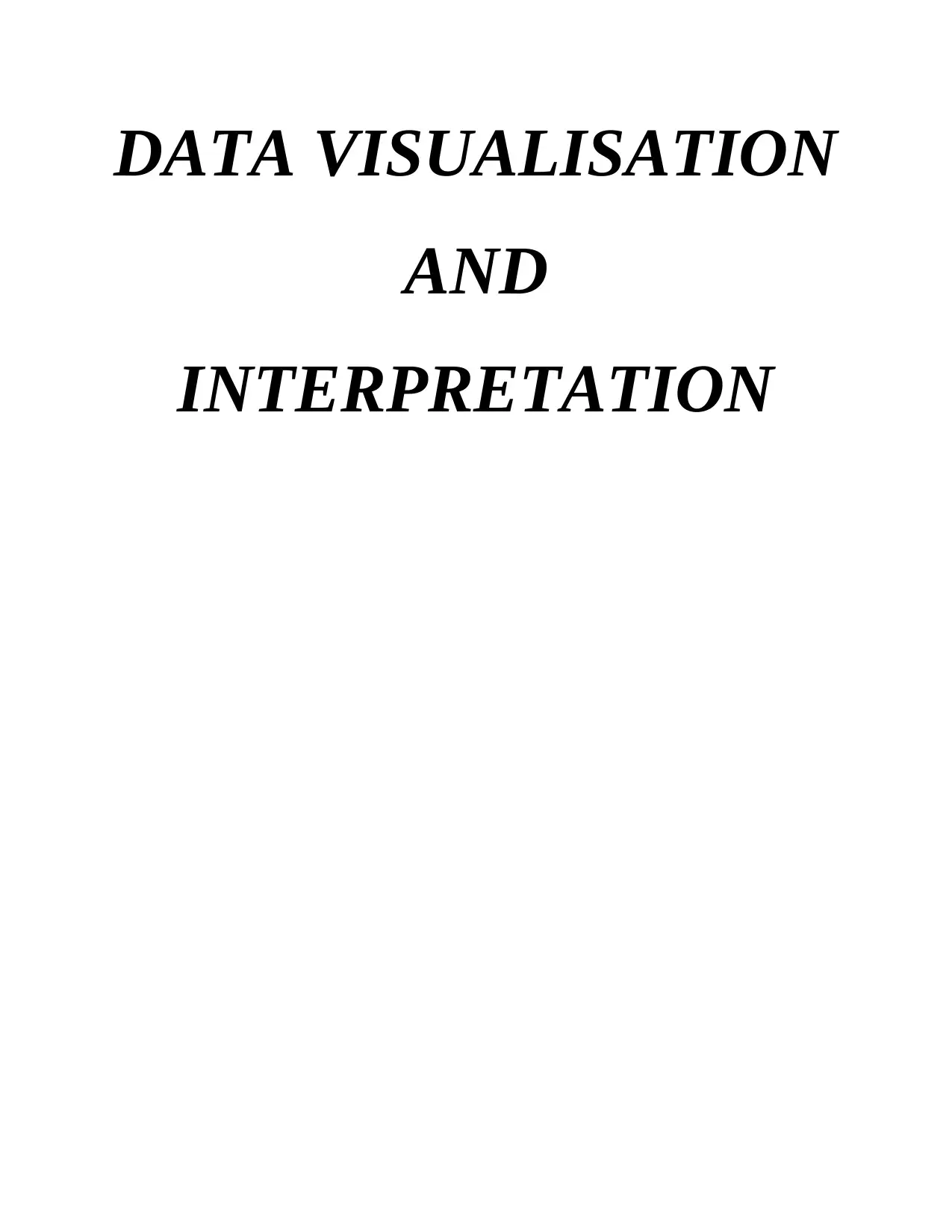
DATA VISUALISATION
AND
INTERPRETATION
AND
INTERPRETATION
Secure Best Marks with AI Grader
Need help grading? Try our AI Grader for instant feedback on your assignments.
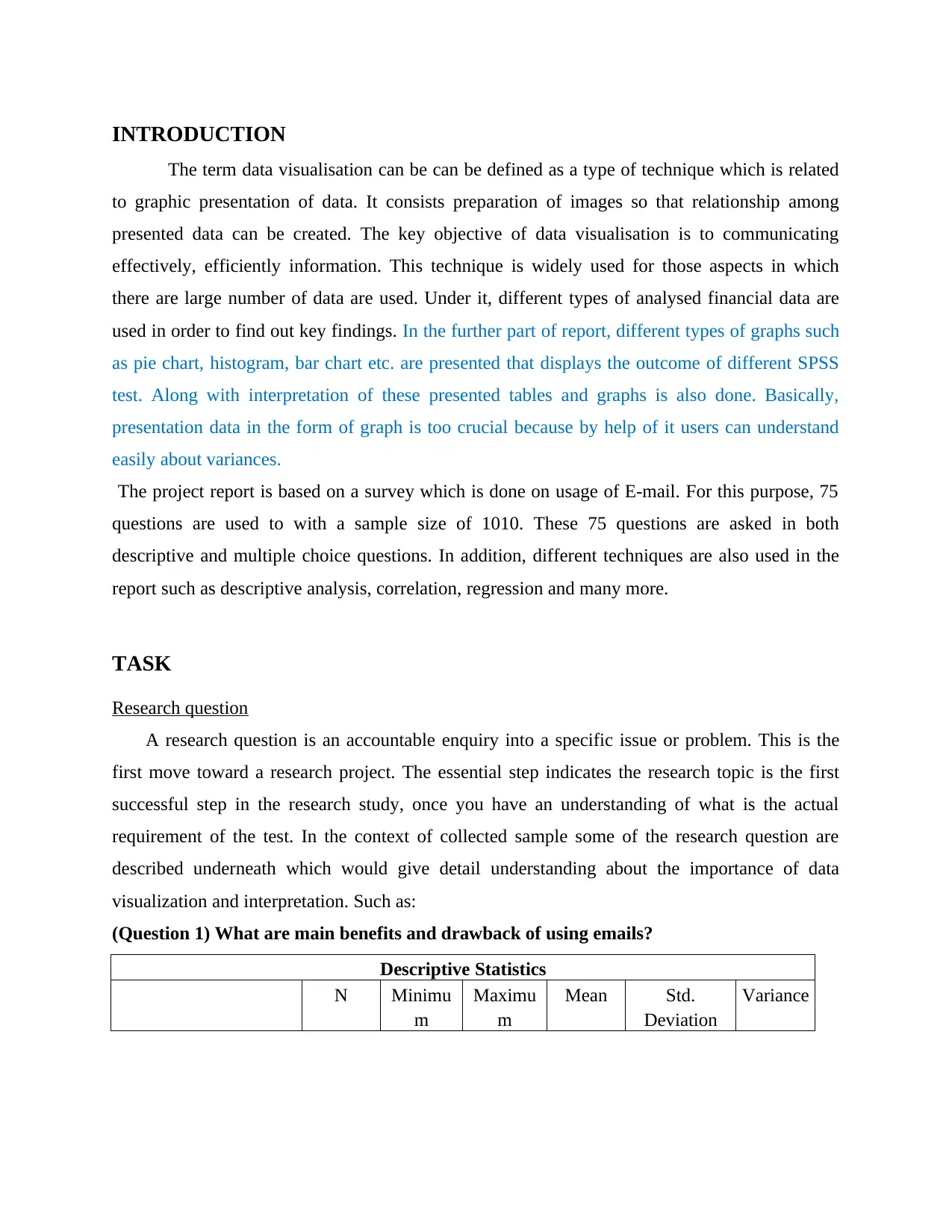
INTRODUCTION
The term data visualisation can be can be defined as a type of technique which is related
to graphic presentation of data. It consists preparation of images so that relationship among
presented data can be created. The key objective of data visualisation is to communicating
effectively, efficiently information. This technique is widely used for those aspects in which
there are large number of data are used. Under it, different types of analysed financial data are
used in order to find out key findings. In the further part of report, different types of graphs such
as pie chart, histogram, bar chart etc. are presented that displays the outcome of different SPSS
test. Along with interpretation of these presented tables and graphs is also done. Basically,
presentation data in the form of graph is too crucial because by help of it users can understand
easily about variances.
The project report is based on a survey which is done on usage of E-mail. For this purpose, 75
questions are used to with a sample size of 1010. These 75 questions are asked in both
descriptive and multiple choice questions. In addition, different techniques are also used in the
report such as descriptive analysis, correlation, regression and many more.
TASK
Research question
A research question is an accountable enquiry into a specific issue or problem. This is the
first move toward a research project. The essential step indicates the research topic is the first
successful step in the research study, once you have an understanding of what is the actual
requirement of the test. In the context of collected sample some of the research question are
described underneath which would give detail understanding about the importance of data
visualization and interpretation. Such as:
(Question 1) What are main benefits and drawback of using emails?
Descriptive Statistics
N Minimu
m
Maximu
m
Mean Std.
Deviation
Variance
The term data visualisation can be can be defined as a type of technique which is related
to graphic presentation of data. It consists preparation of images so that relationship among
presented data can be created. The key objective of data visualisation is to communicating
effectively, efficiently information. This technique is widely used for those aspects in which
there are large number of data are used. Under it, different types of analysed financial data are
used in order to find out key findings. In the further part of report, different types of graphs such
as pie chart, histogram, bar chart etc. are presented that displays the outcome of different SPSS
test. Along with interpretation of these presented tables and graphs is also done. Basically,
presentation data in the form of graph is too crucial because by help of it users can understand
easily about variances.
The project report is based on a survey which is done on usage of E-mail. For this purpose, 75
questions are used to with a sample size of 1010. These 75 questions are asked in both
descriptive and multiple choice questions. In addition, different techniques are also used in the
report such as descriptive analysis, correlation, regression and many more.
TASK
Research question
A research question is an accountable enquiry into a specific issue or problem. This is the
first move toward a research project. The essential step indicates the research topic is the first
successful step in the research study, once you have an understanding of what is the actual
requirement of the test. In the context of collected sample some of the research question are
described underneath which would give detail understanding about the importance of data
visualization and interpretation. Such as:
(Question 1) What are main benefits and drawback of using emails?
Descriptive Statistics
N Minimu
m
Maximu
m
Mean Std.
Deviation
Variance
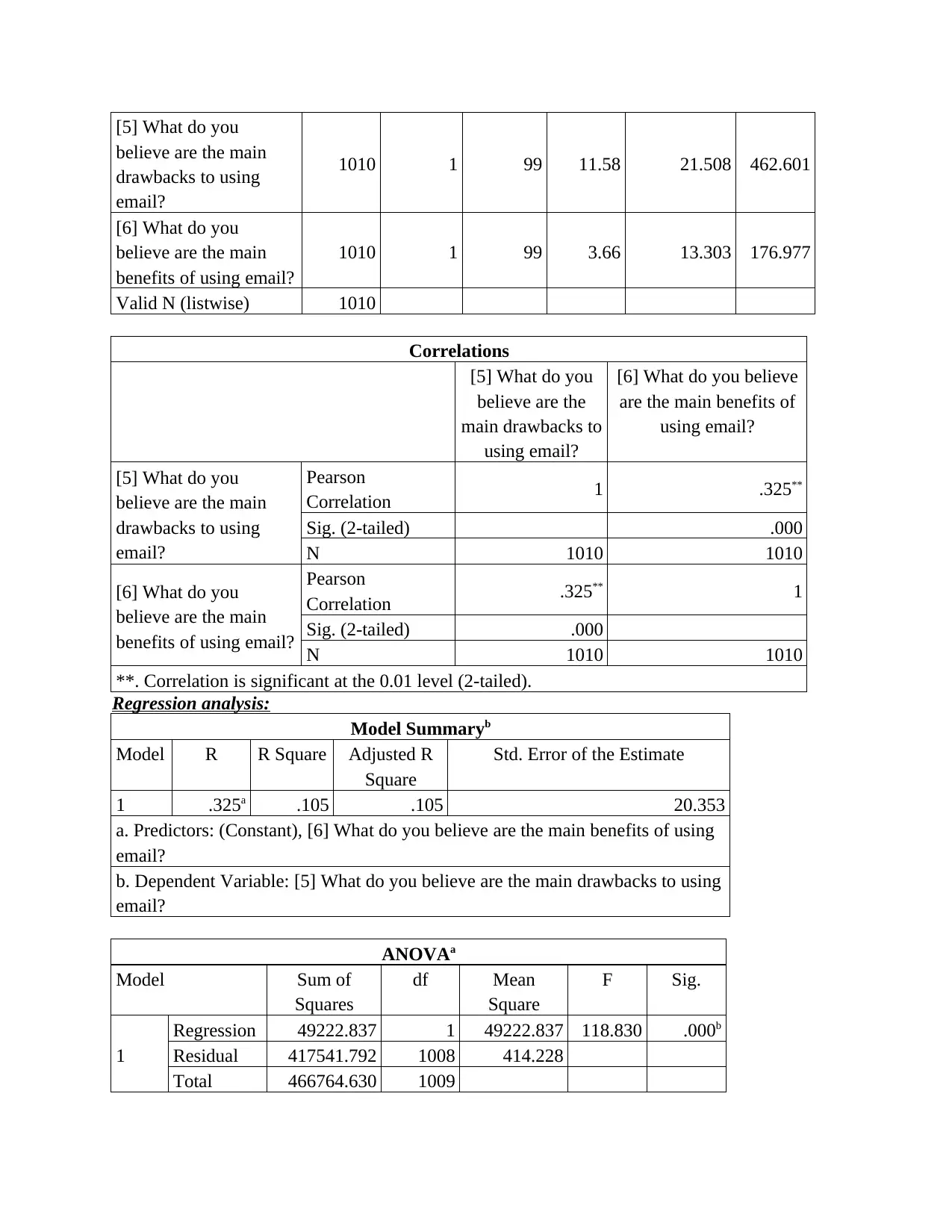
[5] What do you
believe are the main
drawbacks to using
email?
1010 1 99 11.58 21.508 462.601
[6] What do you
believe are the main
benefits of using email?
1010 1 99 3.66 13.303 176.977
Valid N (listwise) 1010
Correlations
[5] What do you
believe are the
main drawbacks to
using email?
[6] What do you believe
are the main benefits of
using email?
[5] What do you
believe are the main
drawbacks to using
email?
Pearson
Correlation 1 .325**
Sig. (2-tailed) .000
N 1010 1010
[6] What do you
believe are the main
benefits of using email?
Pearson
Correlation .325** 1
Sig. (2-tailed) .000
N 1010 1010
**. Correlation is significant at the 0.01 level (2-tailed).
Regression analysis:
Model Summaryb
Model R R Square Adjusted R
Square
Std. Error of the Estimate
1 .325a .105 .105 20.353
a. Predictors: (Constant), [6] What do you believe are the main benefits of using
email?
b. Dependent Variable: [5] What do you believe are the main drawbacks to using
email?
ANOVAa
Model Sum of
Squares
df Mean
Square
F Sig.
1
Regression 49222.837 1 49222.837 118.830 .000b
Residual 417541.792 1008 414.228
Total 466764.630 1009
believe are the main
drawbacks to using
email?
1010 1 99 11.58 21.508 462.601
[6] What do you
believe are the main
benefits of using email?
1010 1 99 3.66 13.303 176.977
Valid N (listwise) 1010
Correlations
[5] What do you
believe are the
main drawbacks to
using email?
[6] What do you believe
are the main benefits of
using email?
[5] What do you
believe are the main
drawbacks to using
email?
Pearson
Correlation 1 .325**
Sig. (2-tailed) .000
N 1010 1010
[6] What do you
believe are the main
benefits of using email?
Pearson
Correlation .325** 1
Sig. (2-tailed) .000
N 1010 1010
**. Correlation is significant at the 0.01 level (2-tailed).
Regression analysis:
Model Summaryb
Model R R Square Adjusted R
Square
Std. Error of the Estimate
1 .325a .105 .105 20.353
a. Predictors: (Constant), [6] What do you believe are the main benefits of using
email?
b. Dependent Variable: [5] What do you believe are the main drawbacks to using
email?
ANOVAa
Model Sum of
Squares
df Mean
Square
F Sig.
1
Regression 49222.837 1 49222.837 118.830 .000b
Residual 417541.792 1008 414.228
Total 466764.630 1009
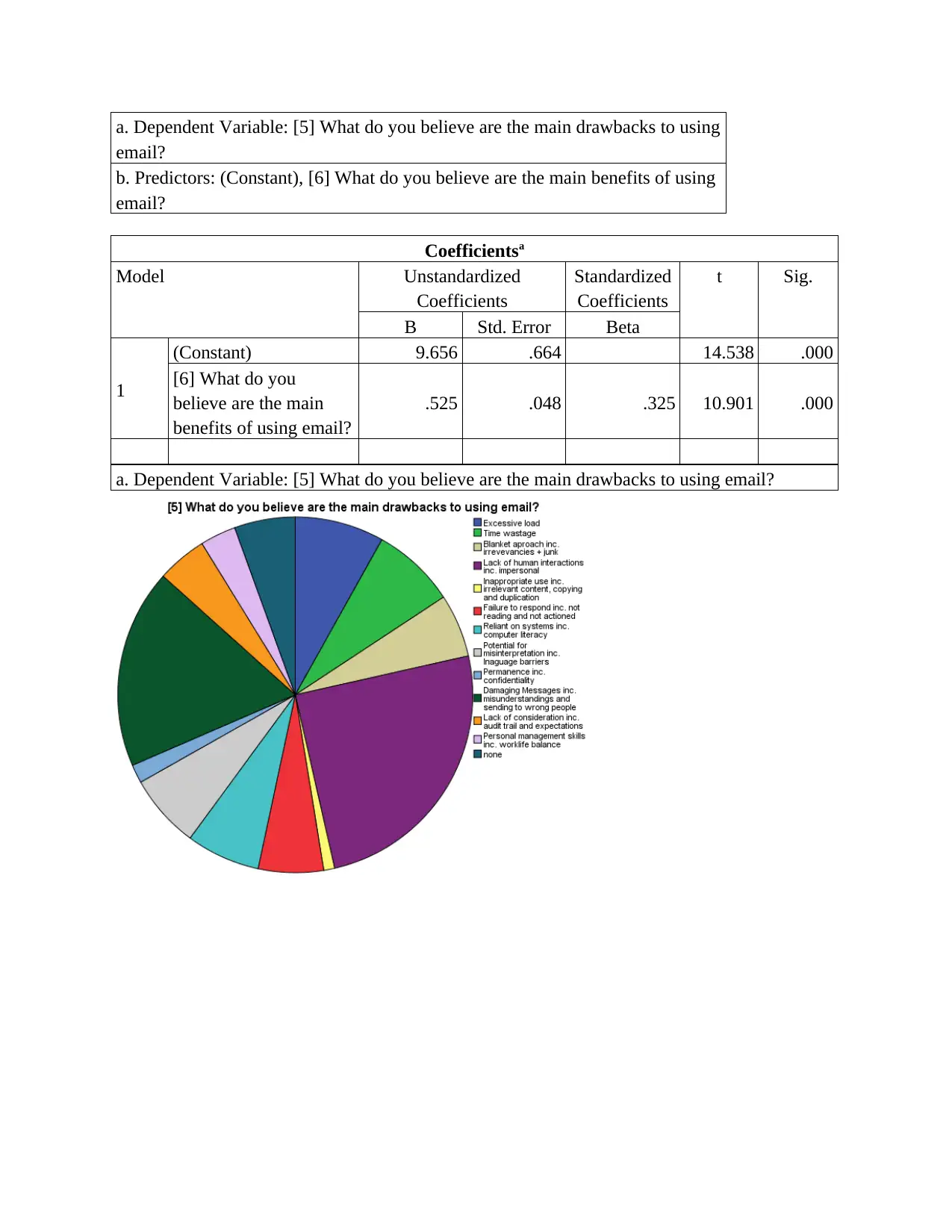
a. Dependent Variable: [5] What do you believe are the main drawbacks to using
email?
b. Predictors: (Constant), [6] What do you believe are the main benefits of using
email?
Coefficientsa
Model Unstandardized
Coefficients
Standardized
Coefficients
t Sig.
B Std. Error Beta
1
(Constant) 9.656 .664 14.538 .000
[6] What do you
believe are the main
benefits of using email?
.525 .048 .325 10.901 .000
a. Dependent Variable: [5] What do you believe are the main drawbacks to using email?
email?
b. Predictors: (Constant), [6] What do you believe are the main benefits of using
email?
Coefficientsa
Model Unstandardized
Coefficients
Standardized
Coefficients
t Sig.
B Std. Error Beta
1
(Constant) 9.656 .664 14.538 .000
[6] What do you
believe are the main
benefits of using email?
.525 .048 .325 10.901 .000
a. Dependent Variable: [5] What do you believe are the main drawbacks to using email?
Secure Best Marks with AI Grader
Need help grading? Try our AI Grader for instant feedback on your assignments.
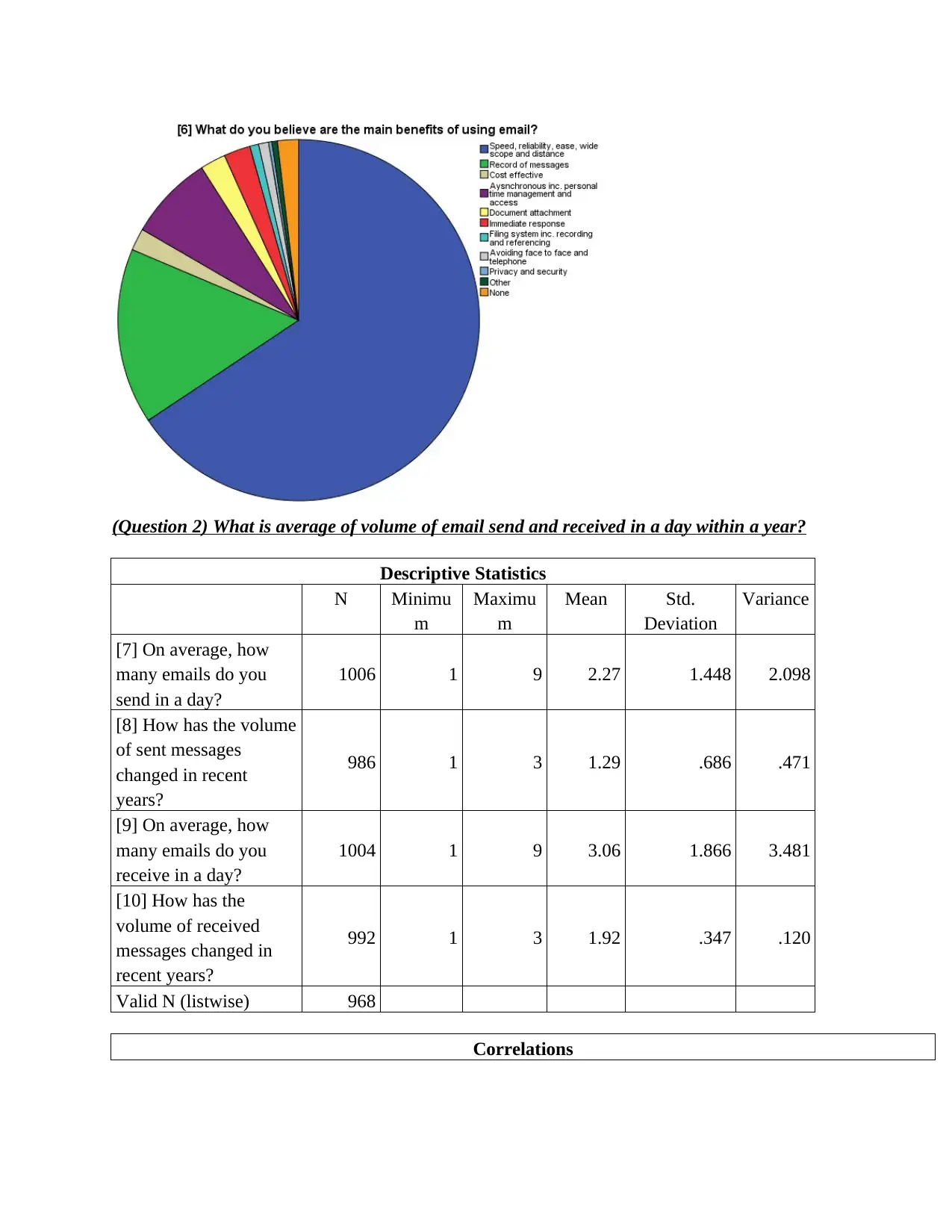
(Question 2) What is average of volume of email send and received in a day within a year?
Descriptive Statistics
N Minimu
m
Maximu
m
Mean Std.
Deviation
Variance
[7] On average, how
many emails do you
send in a day?
1006 1 9 2.27 1.448 2.098
[8] How has the volume
of sent messages
changed in recent
years?
986 1 3 1.29 .686 .471
[9] On average, how
many emails do you
receive in a day?
1004 1 9 3.06 1.866 3.481
[10] How has the
volume of received
messages changed in
recent years?
992 1 3 1.92 .347 .120
Valid N (listwise) 968
Correlations
Descriptive Statistics
N Minimu
m
Maximu
m
Mean Std.
Deviation
Variance
[7] On average, how
many emails do you
send in a day?
1006 1 9 2.27 1.448 2.098
[8] How has the volume
of sent messages
changed in recent
years?
986 1 3 1.29 .686 .471
[9] On average, how
many emails do you
receive in a day?
1004 1 9 3.06 1.866 3.481
[10] How has the
volume of received
messages changed in
recent years?
992 1 3 1.92 .347 .120
Valid N (listwise) 968
Correlations
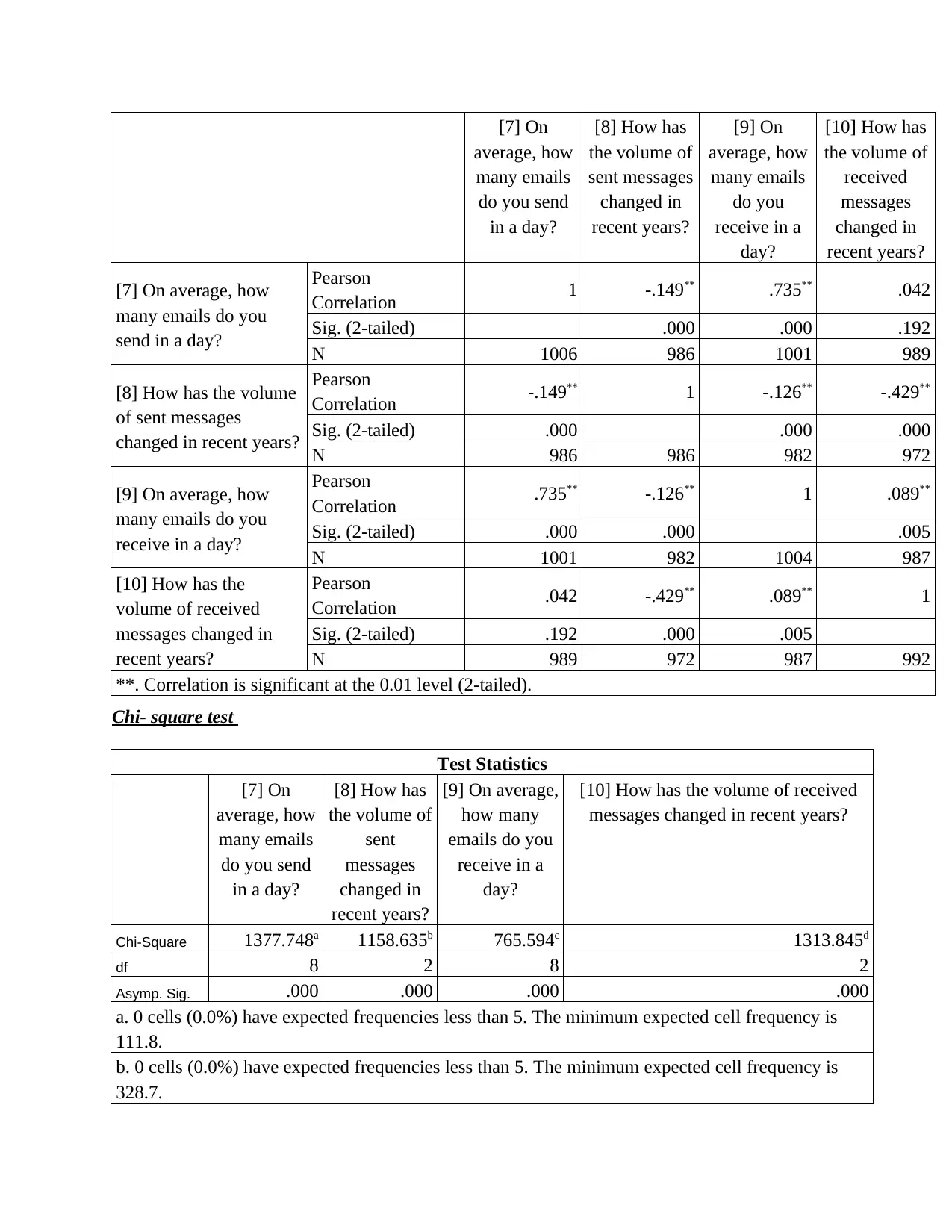
[7] On
average, how
many emails
do you send
in a day?
[8] How has
the volume of
sent messages
changed in
recent years?
[9] On
average, how
many emails
do you
receive in a
day?
[10] How has
the volume of
received
messages
changed in
recent years?
[7] On average, how
many emails do you
send in a day?
Pearson
Correlation 1 -.149** .735** .042
Sig. (2-tailed) .000 .000 .192
N 1006 986 1001 989
[8] How has the volume
of sent messages
changed in recent years?
Pearson
Correlation -.149** 1 -.126** -.429**
Sig. (2-tailed) .000 .000 .000
N 986 986 982 972
[9] On average, how
many emails do you
receive in a day?
Pearson
Correlation .735** -.126** 1 .089**
Sig. (2-tailed) .000 .000 .005
N 1001 982 1004 987
[10] How has the
volume of received
messages changed in
recent years?
Pearson
Correlation .042 -.429** .089** 1
Sig. (2-tailed) .192 .000 .005
N 989 972 987 992
**. Correlation is significant at the 0.01 level (2-tailed).
Chi- square test
Test Statistics
[7] On
average, how
many emails
do you send
in a day?
[8] How has
the volume of
sent
messages
changed in
recent years?
[9] On average,
how many
emails do you
receive in a
day?
[10] How has the volume of received
messages changed in recent years?
Chi-Square 1377.748a 1158.635b 765.594c 1313.845d
df 8 2 8 2
Asymp. Sig. .000 .000 .000 .000
a. 0 cells (0.0%) have expected frequencies less than 5. The minimum expected cell frequency is
111.8.
b. 0 cells (0.0%) have expected frequencies less than 5. The minimum expected cell frequency is
328.7.
average, how
many emails
do you send
in a day?
[8] How has
the volume of
sent messages
changed in
recent years?
[9] On
average, how
many emails
do you
receive in a
day?
[10] How has
the volume of
received
messages
changed in
recent years?
[7] On average, how
many emails do you
send in a day?
Pearson
Correlation 1 -.149** .735** .042
Sig. (2-tailed) .000 .000 .192
N 1006 986 1001 989
[8] How has the volume
of sent messages
changed in recent years?
Pearson
Correlation -.149** 1 -.126** -.429**
Sig. (2-tailed) .000 .000 .000
N 986 986 982 972
[9] On average, how
many emails do you
receive in a day?
Pearson
Correlation .735** -.126** 1 .089**
Sig. (2-tailed) .000 .000 .005
N 1001 982 1004 987
[10] How has the
volume of received
messages changed in
recent years?
Pearson
Correlation .042 -.429** .089** 1
Sig. (2-tailed) .192 .000 .005
N 989 972 987 992
**. Correlation is significant at the 0.01 level (2-tailed).
Chi- square test
Test Statistics
[7] On
average, how
many emails
do you send
in a day?
[8] How has
the volume of
sent
messages
changed in
recent years?
[9] On average,
how many
emails do you
receive in a
day?
[10] How has the volume of received
messages changed in recent years?
Chi-Square 1377.748a 1158.635b 765.594c 1313.845d
df 8 2 8 2
Asymp. Sig. .000 .000 .000 .000
a. 0 cells (0.0%) have expected frequencies less than 5. The minimum expected cell frequency is
111.8.
b. 0 cells (0.0%) have expected frequencies less than 5. The minimum expected cell frequency is
328.7.
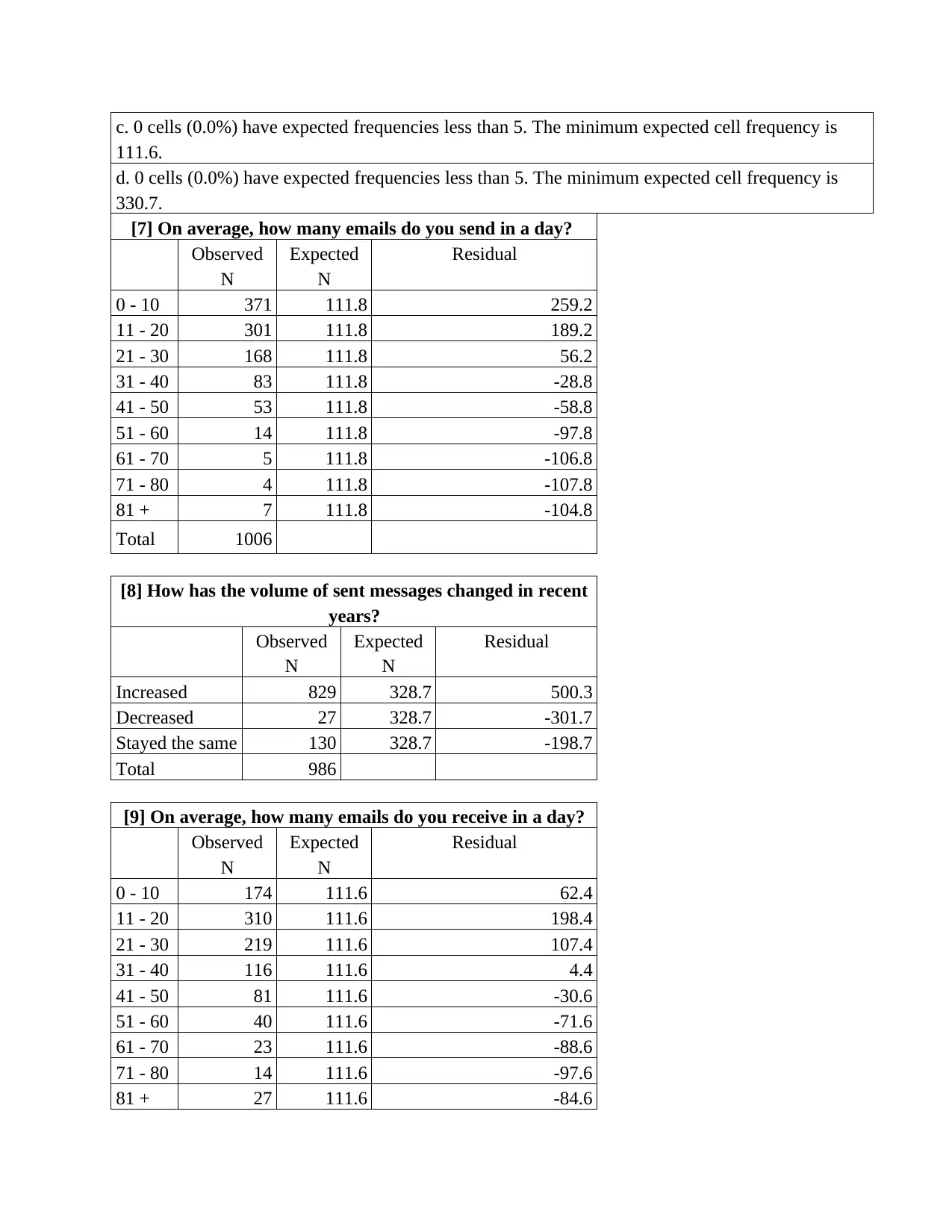
c. 0 cells (0.0%) have expected frequencies less than 5. The minimum expected cell frequency is
111.6.
d. 0 cells (0.0%) have expected frequencies less than 5. The minimum expected cell frequency is
330.7.
[7] On average, how many emails do you send in a day?
Observed
N
Expected
N
Residual
0 - 10 371 111.8 259.2
11 - 20 301 111.8 189.2
21 - 30 168 111.8 56.2
31 - 40 83 111.8 -28.8
41 - 50 53 111.8 -58.8
51 - 60 14 111.8 -97.8
61 - 70 5 111.8 -106.8
71 - 80 4 111.8 -107.8
81 + 7 111.8 -104.8
Total 1006
[8] How has the volume of sent messages changed in recent
years?
Observed
N
Expected
N
Residual
Increased 829 328.7 500.3
Decreased 27 328.7 -301.7
Stayed the same 130 328.7 -198.7
Total 986
[9] On average, how many emails do you receive in a day?
Observed
N
Expected
N
Residual
0 - 10 174 111.6 62.4
11 - 20 310 111.6 198.4
21 - 30 219 111.6 107.4
31 - 40 116 111.6 4.4
41 - 50 81 111.6 -30.6
51 - 60 40 111.6 -71.6
61 - 70 23 111.6 -88.6
71 - 80 14 111.6 -97.6
81 + 27 111.6 -84.6
111.6.
d. 0 cells (0.0%) have expected frequencies less than 5. The minimum expected cell frequency is
330.7.
[7] On average, how many emails do you send in a day?
Observed
N
Expected
N
Residual
0 - 10 371 111.8 259.2
11 - 20 301 111.8 189.2
21 - 30 168 111.8 56.2
31 - 40 83 111.8 -28.8
41 - 50 53 111.8 -58.8
51 - 60 14 111.8 -97.8
61 - 70 5 111.8 -106.8
71 - 80 4 111.8 -107.8
81 + 7 111.8 -104.8
Total 1006
[8] How has the volume of sent messages changed in recent
years?
Observed
N
Expected
N
Residual
Increased 829 328.7 500.3
Decreased 27 328.7 -301.7
Stayed the same 130 328.7 -198.7
Total 986
[9] On average, how many emails do you receive in a day?
Observed
N
Expected
N
Residual
0 - 10 174 111.6 62.4
11 - 20 310 111.6 198.4
21 - 30 219 111.6 107.4
31 - 40 116 111.6 4.4
41 - 50 81 111.6 -30.6
51 - 60 40 111.6 -71.6
61 - 70 23 111.6 -88.6
71 - 80 14 111.6 -97.6
81 + 27 111.6 -84.6
Paraphrase This Document
Need a fresh take? Get an instant paraphrase of this document with our AI Paraphraser
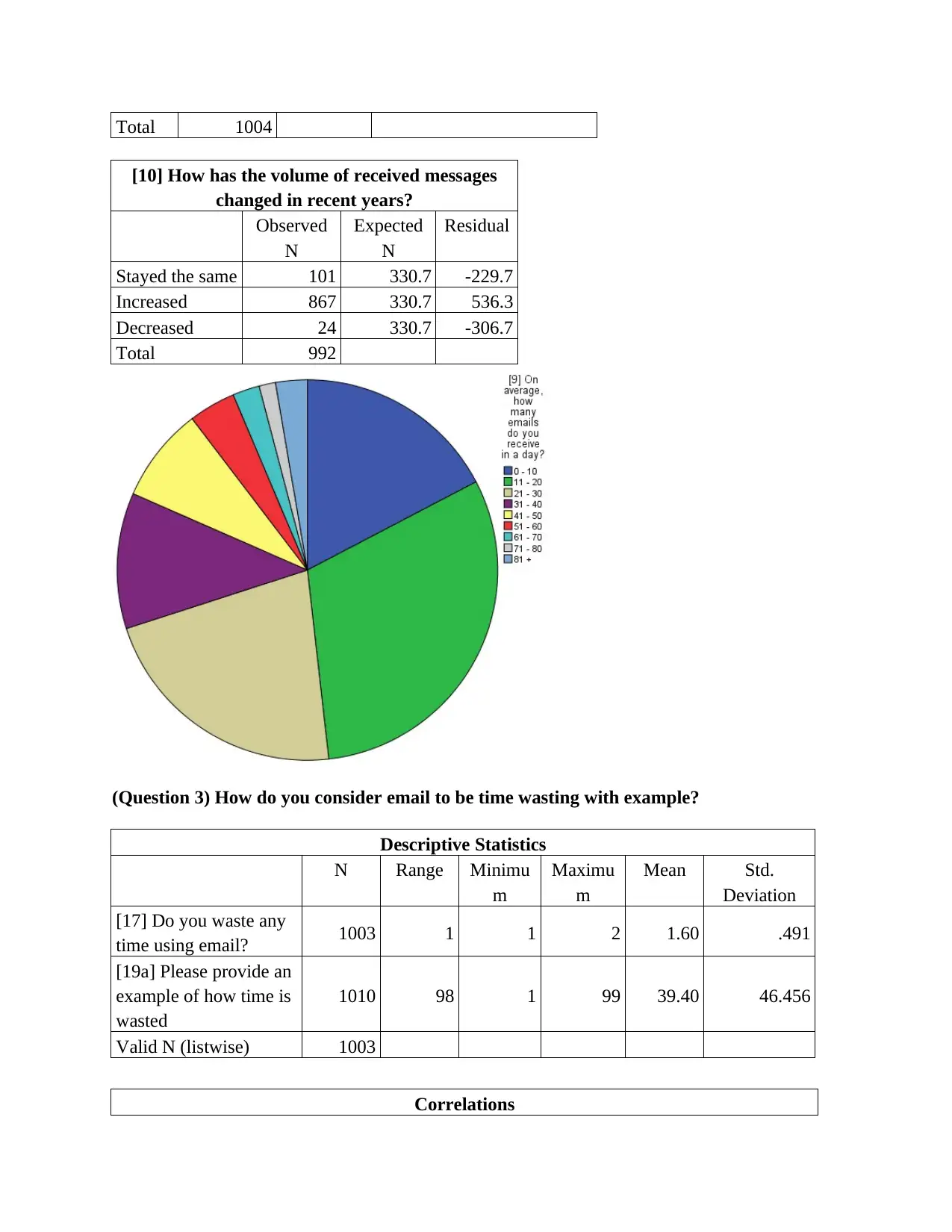
Total 1004
[10] How has the volume of received messages
changed in recent years?
Observed
N
Expected
N
Residual
Stayed the same 101 330.7 -229.7
Increased 867 330.7 536.3
Decreased 24 330.7 -306.7
Total 992
(Question 3) How do you consider email to be time wasting with example?
Descriptive Statistics
N Range Minimu
m
Maximu
m
Mean Std.
Deviation
[17] Do you waste any
time using email? 1003 1 1 2 1.60 .491
[19a] Please provide an
example of how time is
wasted
1010 98 1 99 39.40 46.456
Valid N (listwise) 1003
Correlations
[10] How has the volume of received messages
changed in recent years?
Observed
N
Expected
N
Residual
Stayed the same 101 330.7 -229.7
Increased 867 330.7 536.3
Decreased 24 330.7 -306.7
Total 992
(Question 3) How do you consider email to be time wasting with example?
Descriptive Statistics
N Range Minimu
m
Maximu
m
Mean Std.
Deviation
[17] Do you waste any
time using email? 1003 1 1 2 1.60 .491
[19a] Please provide an
example of how time is
wasted
1010 98 1 99 39.40 46.456
Valid N (listwise) 1003
Correlations
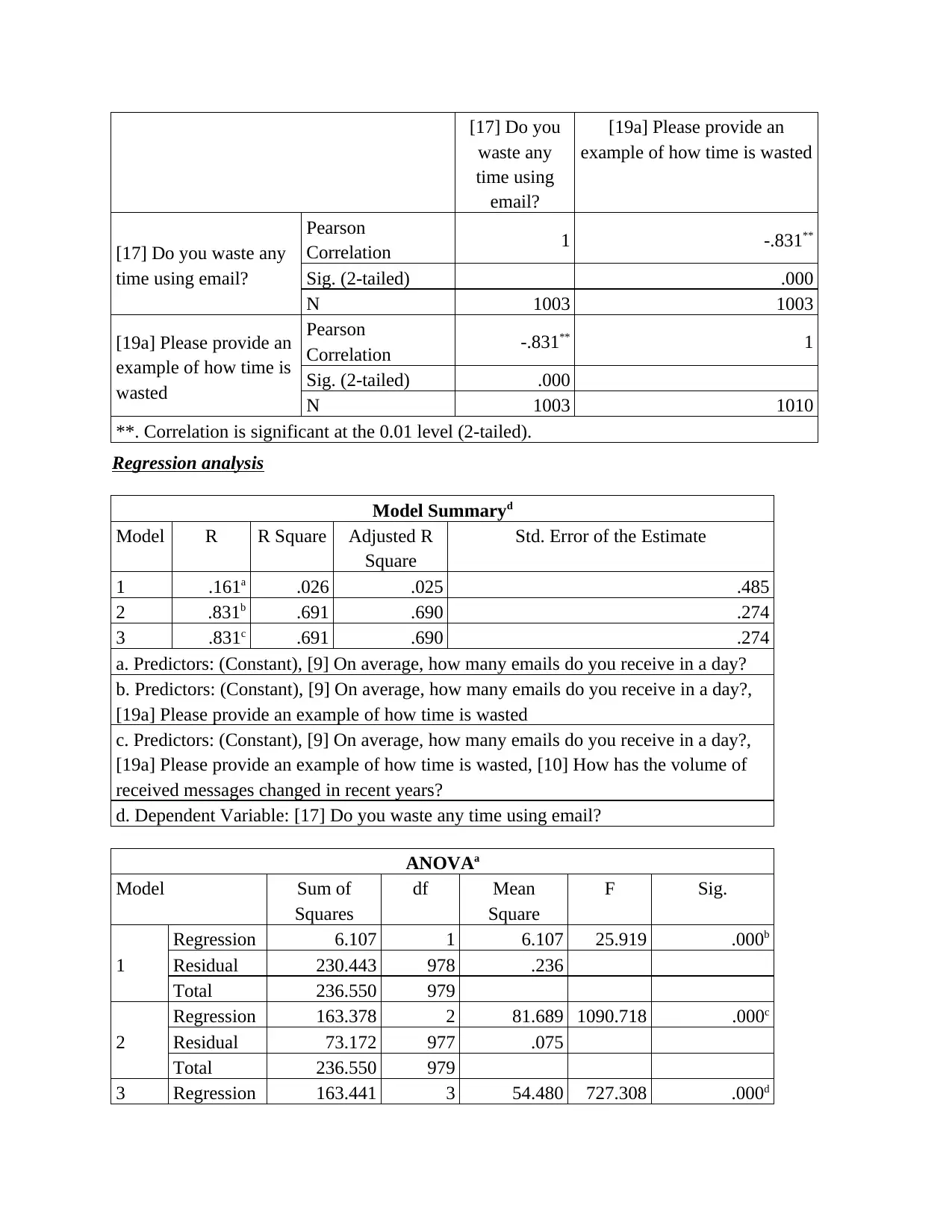
[17] Do you
waste any
time using
email?
[19a] Please provide an
example of how time is wasted
[17] Do you waste any
time using email?
Pearson
Correlation 1 -.831**
Sig. (2-tailed) .000
N 1003 1003
[19a] Please provide an
example of how time is
wasted
Pearson
Correlation -.831** 1
Sig. (2-tailed) .000
N 1003 1010
**. Correlation is significant at the 0.01 level (2-tailed).
Regression analysis
Model Summaryd
Model R R Square Adjusted R
Square
Std. Error of the Estimate
1 .161a .026 .025 .485
2 .831b .691 .690 .274
3 .831c .691 .690 .274
a. Predictors: (Constant), [9] On average, how many emails do you receive in a day?
b. Predictors: (Constant), [9] On average, how many emails do you receive in a day?,
[19a] Please provide an example of how time is wasted
c. Predictors: (Constant), [9] On average, how many emails do you receive in a day?,
[19a] Please provide an example of how time is wasted, [10] How has the volume of
received messages changed in recent years?
d. Dependent Variable: [17] Do you waste any time using email?
ANOVAa
Model Sum of
Squares
df Mean
Square
F Sig.
1
Regression 6.107 1 6.107 25.919 .000b
Residual 230.443 978 .236
Total 236.550 979
2
Regression 163.378 2 81.689 1090.718 .000c
Residual 73.172 977 .075
Total 236.550 979
3 Regression 163.441 3 54.480 727.308 .000d
waste any
time using
email?
[19a] Please provide an
example of how time is wasted
[17] Do you waste any
time using email?
Pearson
Correlation 1 -.831**
Sig. (2-tailed) .000
N 1003 1003
[19a] Please provide an
example of how time is
wasted
Pearson
Correlation -.831** 1
Sig. (2-tailed) .000
N 1003 1010
**. Correlation is significant at the 0.01 level (2-tailed).
Regression analysis
Model Summaryd
Model R R Square Adjusted R
Square
Std. Error of the Estimate
1 .161a .026 .025 .485
2 .831b .691 .690 .274
3 .831c .691 .690 .274
a. Predictors: (Constant), [9] On average, how many emails do you receive in a day?
b. Predictors: (Constant), [9] On average, how many emails do you receive in a day?,
[19a] Please provide an example of how time is wasted
c. Predictors: (Constant), [9] On average, how many emails do you receive in a day?,
[19a] Please provide an example of how time is wasted, [10] How has the volume of
received messages changed in recent years?
d. Dependent Variable: [17] Do you waste any time using email?
ANOVAa
Model Sum of
Squares
df Mean
Square
F Sig.
1
Regression 6.107 1 6.107 25.919 .000b
Residual 230.443 978 .236
Total 236.550 979
2
Regression 163.378 2 81.689 1090.718 .000c
Residual 73.172 977 .075
Total 236.550 979
3 Regression 163.441 3 54.480 727.308 .000d
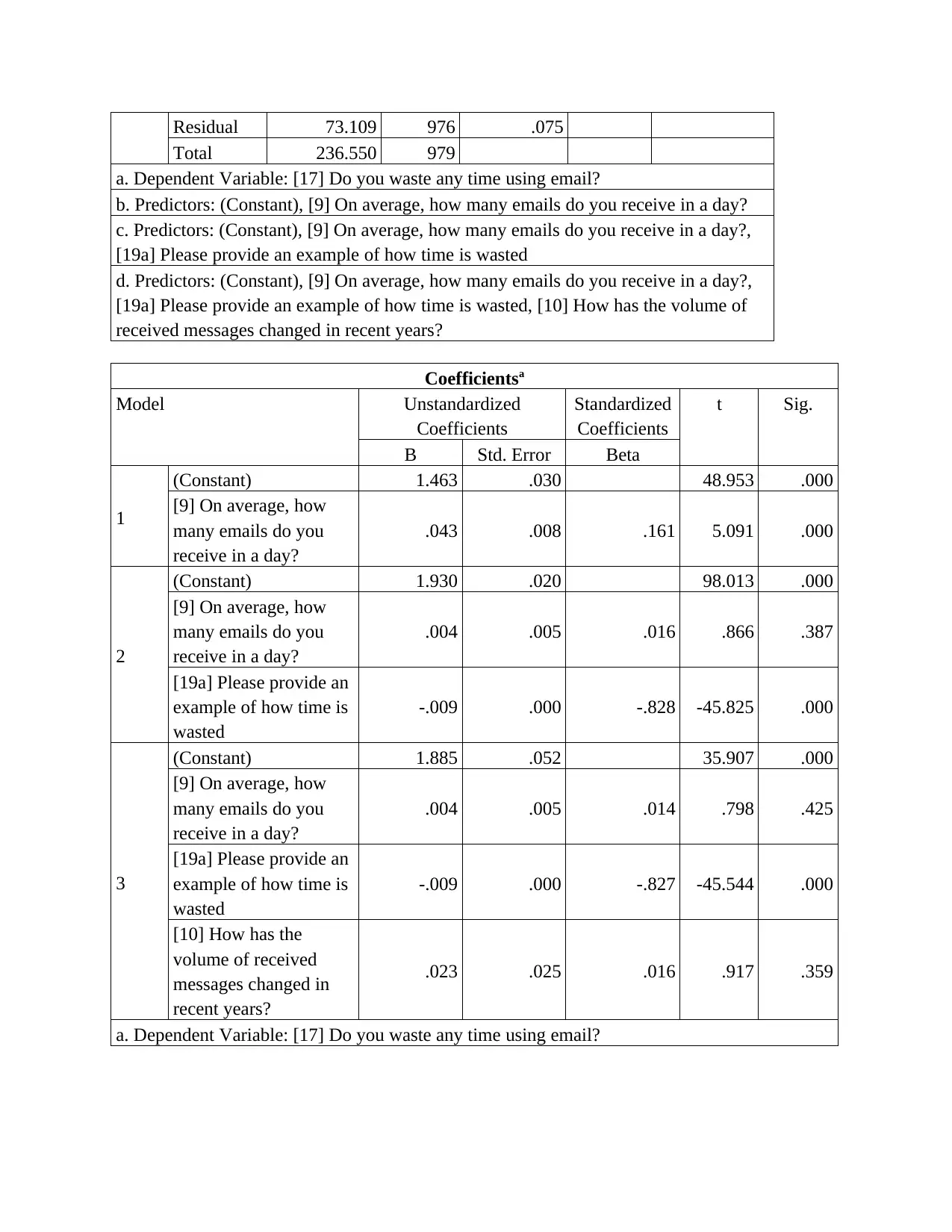
Residual 73.109 976 .075
Total 236.550 979
a. Dependent Variable: [17] Do you waste any time using email?
b. Predictors: (Constant), [9] On average, how many emails do you receive in a day?
c. Predictors: (Constant), [9] On average, how many emails do you receive in a day?,
[19a] Please provide an example of how time is wasted
d. Predictors: (Constant), [9] On average, how many emails do you receive in a day?,
[19a] Please provide an example of how time is wasted, [10] How has the volume of
received messages changed in recent years?
Coefficientsa
Model Unstandardized
Coefficients
Standardized
Coefficients
t Sig.
B Std. Error Beta
1
(Constant) 1.463 .030 48.953 .000
[9] On average, how
many emails do you
receive in a day?
.043 .008 .161 5.091 .000
2
(Constant) 1.930 .020 98.013 .000
[9] On average, how
many emails do you
receive in a day?
.004 .005 .016 .866 .387
[19a] Please provide an
example of how time is
wasted
-.009 .000 -.828 -45.825 .000
3
(Constant) 1.885 .052 35.907 .000
[9] On average, how
many emails do you
receive in a day?
.004 .005 .014 .798 .425
[19a] Please provide an
example of how time is
wasted
-.009 .000 -.827 -45.544 .000
[10] How has the
volume of received
messages changed in
recent years?
.023 .025 .016 .917 .359
a. Dependent Variable: [17] Do you waste any time using email?
Total 236.550 979
a. Dependent Variable: [17] Do you waste any time using email?
b. Predictors: (Constant), [9] On average, how many emails do you receive in a day?
c. Predictors: (Constant), [9] On average, how many emails do you receive in a day?,
[19a] Please provide an example of how time is wasted
d. Predictors: (Constant), [9] On average, how many emails do you receive in a day?,
[19a] Please provide an example of how time is wasted, [10] How has the volume of
received messages changed in recent years?
Coefficientsa
Model Unstandardized
Coefficients
Standardized
Coefficients
t Sig.
B Std. Error Beta
1
(Constant) 1.463 .030 48.953 .000
[9] On average, how
many emails do you
receive in a day?
.043 .008 .161 5.091 .000
2
(Constant) 1.930 .020 98.013 .000
[9] On average, how
many emails do you
receive in a day?
.004 .005 .016 .866 .387
[19a] Please provide an
example of how time is
wasted
-.009 .000 -.828 -45.825 .000
3
(Constant) 1.885 .052 35.907 .000
[9] On average, how
many emails do you
receive in a day?
.004 .005 .014 .798 .425
[19a] Please provide an
example of how time is
wasted
-.009 .000 -.827 -45.544 .000
[10] How has the
volume of received
messages changed in
recent years?
.023 .025 .016 .917 .359
a. Dependent Variable: [17] Do you waste any time using email?
Secure Best Marks with AI Grader
Need help grading? Try our AI Grader for instant feedback on your assignments.
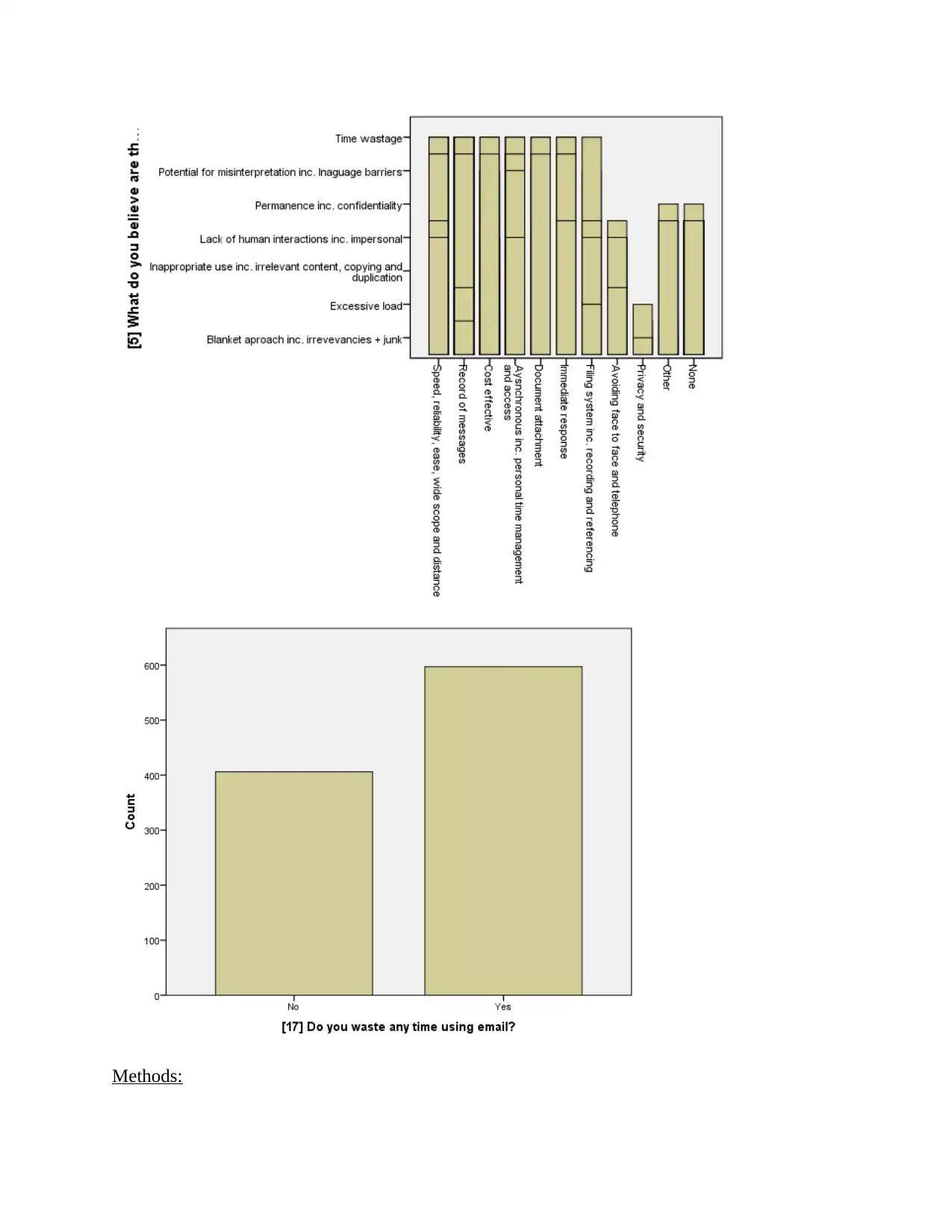
Methods:
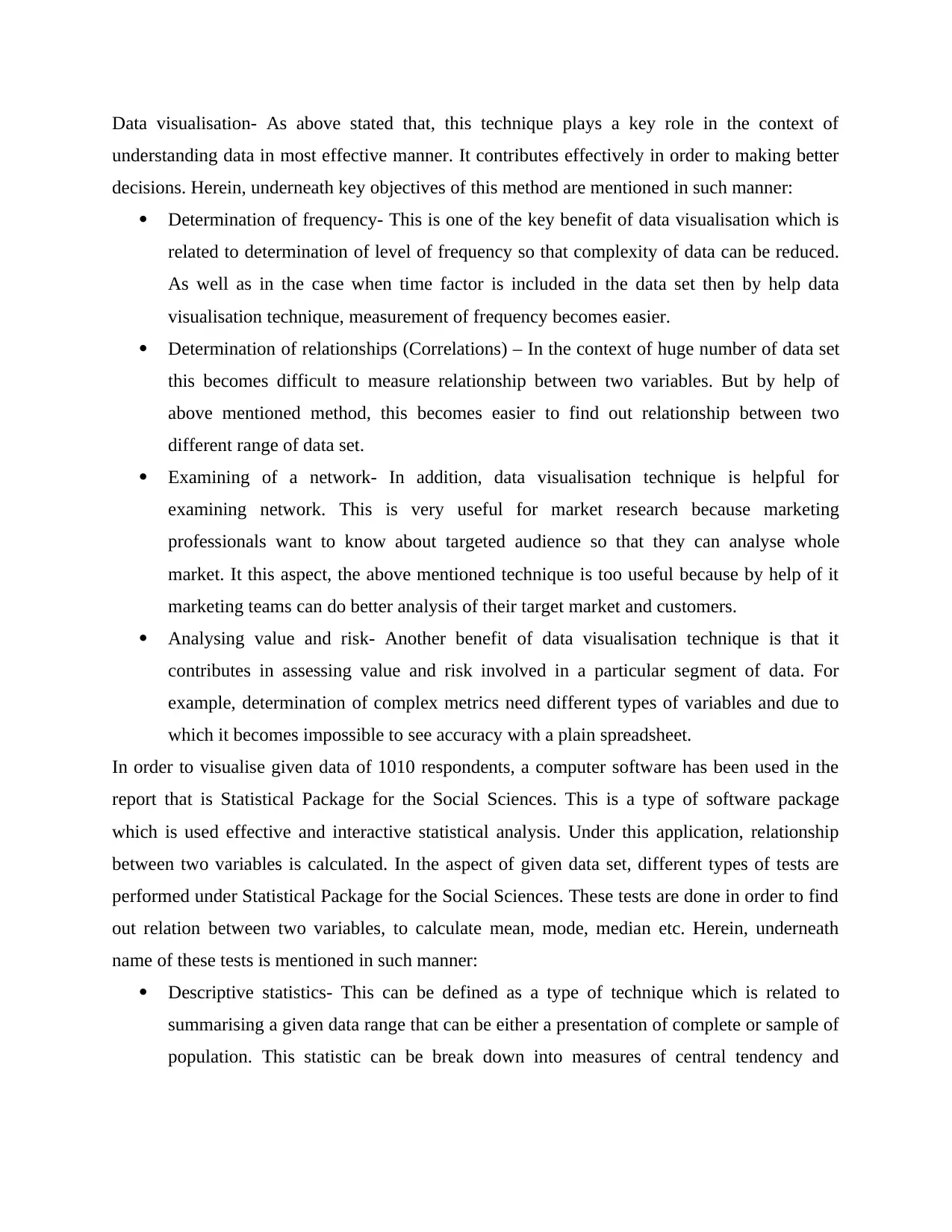
Data visualisation- As above stated that, this technique plays a key role in the context of
understanding data in most effective manner. It contributes effectively in order to making better
decisions. Herein, underneath key objectives of this method are mentioned in such manner:
Determination of frequency- This is one of the key benefit of data visualisation which is
related to determination of level of frequency so that complexity of data can be reduced.
As well as in the case when time factor is included in the data set then by help data
visualisation technique, measurement of frequency becomes easier.
Determination of relationships (Correlations) – In the context of huge number of data set
this becomes difficult to measure relationship between two variables. But by help of
above mentioned method, this becomes easier to find out relationship between two
different range of data set.
Examining of a network- In addition, data visualisation technique is helpful for
examining network. This is very useful for market research because marketing
professionals want to know about targeted audience so that they can analyse whole
market. It this aspect, the above mentioned technique is too useful because by help of it
marketing teams can do better analysis of their target market and customers.
Analysing value and risk- Another benefit of data visualisation technique is that it
contributes in assessing value and risk involved in a particular segment of data. For
example, determination of complex metrics need different types of variables and due to
which it becomes impossible to see accuracy with a plain spreadsheet.
In order to visualise given data of 1010 respondents, a computer software has been used in the
report that is Statistical Package for the Social Sciences. This is a type of software package
which is used effective and interactive statistical analysis. Under this application, relationship
between two variables is calculated. In the aspect of given data set, different types of tests are
performed under Statistical Package for the Social Sciences. These tests are done in order to find
out relation between two variables, to calculate mean, mode, median etc. Herein, underneath
name of these tests is mentioned in such manner:
Descriptive statistics- This can be defined as a type of technique which is related to
summarising a given data range that can be either a presentation of complete or sample of
population. This statistic can be break down into measures of central tendency and
understanding data in most effective manner. It contributes effectively in order to making better
decisions. Herein, underneath key objectives of this method are mentioned in such manner:
Determination of frequency- This is one of the key benefit of data visualisation which is
related to determination of level of frequency so that complexity of data can be reduced.
As well as in the case when time factor is included in the data set then by help data
visualisation technique, measurement of frequency becomes easier.
Determination of relationships (Correlations) – In the context of huge number of data set
this becomes difficult to measure relationship between two variables. But by help of
above mentioned method, this becomes easier to find out relationship between two
different range of data set.
Examining of a network- In addition, data visualisation technique is helpful for
examining network. This is very useful for market research because marketing
professionals want to know about targeted audience so that they can analyse whole
market. It this aspect, the above mentioned technique is too useful because by help of it
marketing teams can do better analysis of their target market and customers.
Analysing value and risk- Another benefit of data visualisation technique is that it
contributes in assessing value and risk involved in a particular segment of data. For
example, determination of complex metrics need different types of variables and due to
which it becomes impossible to see accuracy with a plain spreadsheet.
In order to visualise given data of 1010 respondents, a computer software has been used in the
report that is Statistical Package for the Social Sciences. This is a type of software package
which is used effective and interactive statistical analysis. Under this application, relationship
between two variables is calculated. In the aspect of given data set, different types of tests are
performed under Statistical Package for the Social Sciences. These tests are done in order to find
out relation between two variables, to calculate mean, mode, median etc. Herein, underneath
name of these tests is mentioned in such manner:
Descriptive statistics- This can be defined as a type of technique which is related to
summarising a given data range that can be either a presentation of complete or sample of
population. This statistic can be break down into measures of central tendency and
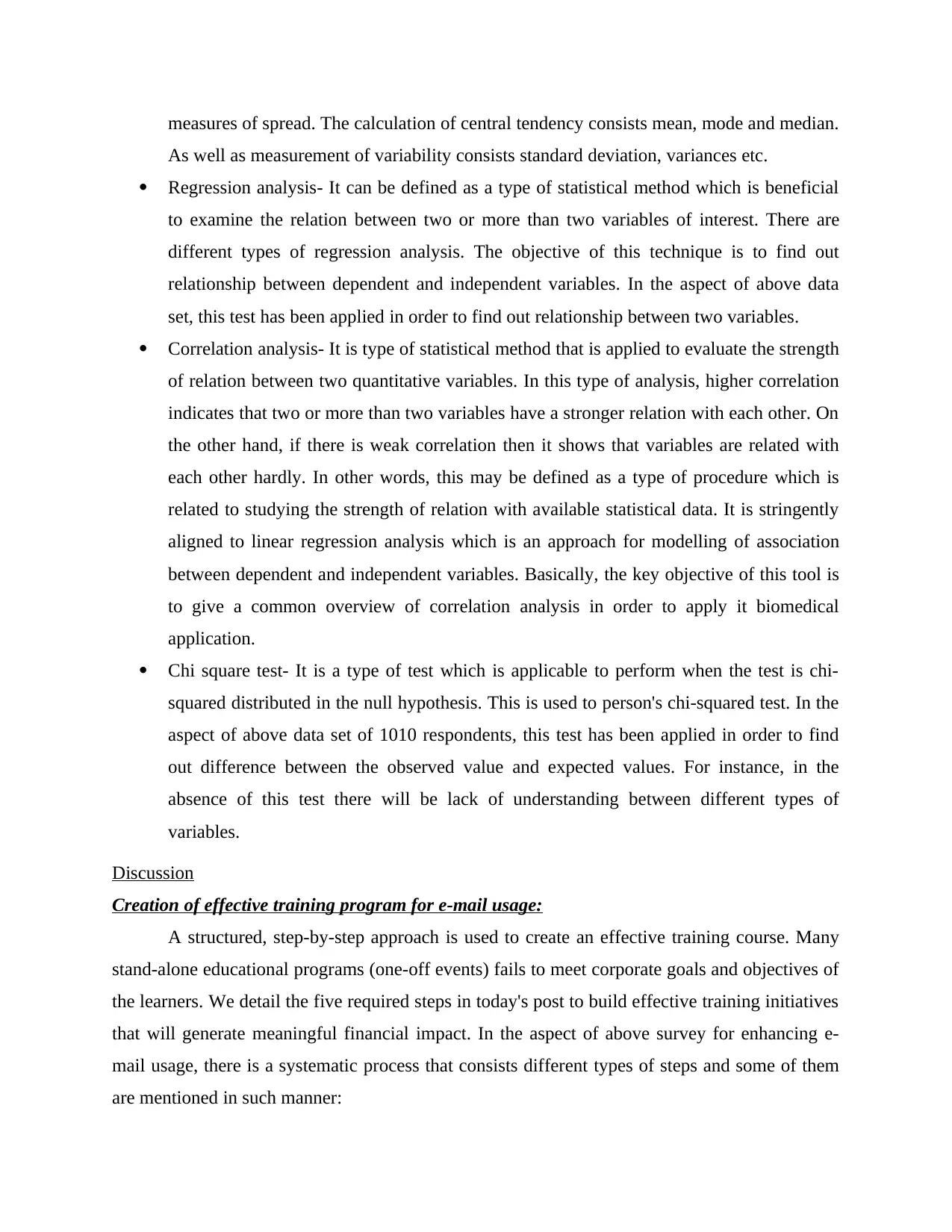
measures of spread. The calculation of central tendency consists mean, mode and median.
As well as measurement of variability consists standard deviation, variances etc.
Regression analysis- It can be defined as a type of statistical method which is beneficial
to examine the relation between two or more than two variables of interest. There are
different types of regression analysis. The objective of this technique is to find out
relationship between dependent and independent variables. In the aspect of above data
set, this test has been applied in order to find out relationship between two variables.
Correlation analysis- It is type of statistical method that is applied to evaluate the strength
of relation between two quantitative variables. In this type of analysis, higher correlation
indicates that two or more than two variables have a stronger relation with each other. On
the other hand, if there is weak correlation then it shows that variables are related with
each other hardly. In other words, this may be defined as a type of procedure which is
related to studying the strength of relation with available statistical data. It is stringently
aligned to linear regression analysis which is an approach for modelling of association
between dependent and independent variables. Basically, the key objective of this tool is
to give a common overview of correlation analysis in order to apply it biomedical
application.
Chi square test- It is a type of test which is applicable to perform when the test is chi-
squared distributed in the null hypothesis. This is used to person's chi-squared test. In the
aspect of above data set of 1010 respondents, this test has been applied in order to find
out difference between the observed value and expected values. For instance, in the
absence of this test there will be lack of understanding between different types of
variables.
Discussion
Creation of effective training program for e-mail usage:
A structured, step-by-step approach is used to create an effective training course. Many
stand-alone educational programs (one-off events) fails to meet corporate goals and objectives of
the learners. We detail the five required steps in today's post to build effective training initiatives
that will generate meaningful financial impact. In the aspect of above survey for enhancing e-
mail usage, there is a systematic process that consists different types of steps and some of them
are mentioned in such manner:
As well as measurement of variability consists standard deviation, variances etc.
Regression analysis- It can be defined as a type of statistical method which is beneficial
to examine the relation between two or more than two variables of interest. There are
different types of regression analysis. The objective of this technique is to find out
relationship between dependent and independent variables. In the aspect of above data
set, this test has been applied in order to find out relationship between two variables.
Correlation analysis- It is type of statistical method that is applied to evaluate the strength
of relation between two quantitative variables. In this type of analysis, higher correlation
indicates that two or more than two variables have a stronger relation with each other. On
the other hand, if there is weak correlation then it shows that variables are related with
each other hardly. In other words, this may be defined as a type of procedure which is
related to studying the strength of relation with available statistical data. It is stringently
aligned to linear regression analysis which is an approach for modelling of association
between dependent and independent variables. Basically, the key objective of this tool is
to give a common overview of correlation analysis in order to apply it biomedical
application.
Chi square test- It is a type of test which is applicable to perform when the test is chi-
squared distributed in the null hypothesis. This is used to person's chi-squared test. In the
aspect of above data set of 1010 respondents, this test has been applied in order to find
out difference between the observed value and expected values. For instance, in the
absence of this test there will be lack of understanding between different types of
variables.
Discussion
Creation of effective training program for e-mail usage:
A structured, step-by-step approach is used to create an effective training course. Many
stand-alone educational programs (one-off events) fails to meet corporate goals and objectives of
the learners. We detail the five required steps in today's post to build effective training initiatives
that will generate meaningful financial impact. In the aspect of above survey for enhancing e-
mail usage, there is a systematic process that consists different types of steps and some of them
are mentioned in such manner:
Paraphrase This Document
Need a fresh take? Get an instant paraphrase of this document with our AI Paraphraser
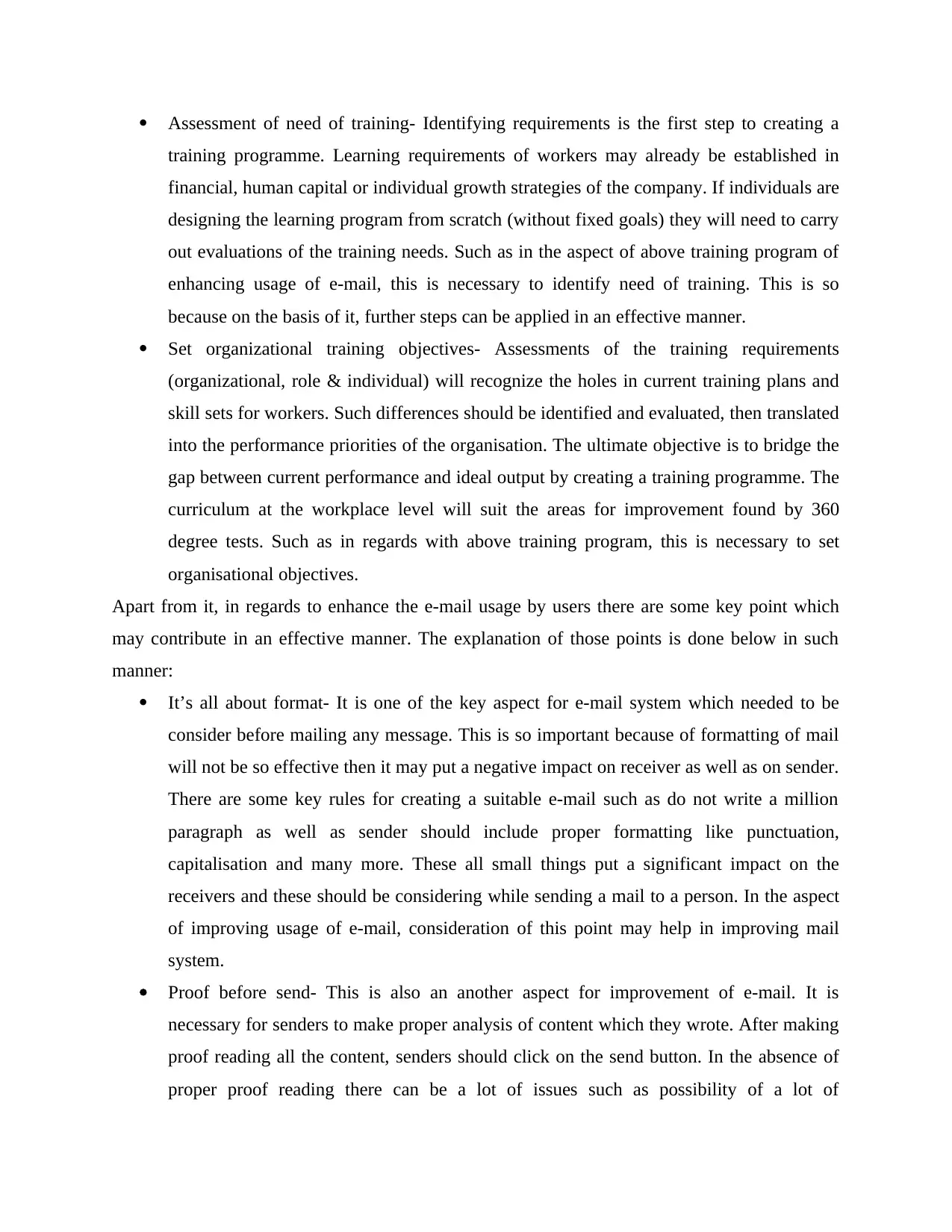
Assessment of need of training- Identifying requirements is the first step to creating a
training programme. Learning requirements of workers may already be established in
financial, human capital or individual growth strategies of the company. If individuals are
designing the learning program from scratch (without fixed goals) they will need to carry
out evaluations of the training needs. Such as in the aspect of above training program of
enhancing usage of e-mail, this is necessary to identify need of training. This is so
because on the basis of it, further steps can be applied in an effective manner.
Set organizational training objectives- Assessments of the training requirements
(organizational, role & individual) will recognize the holes in current training plans and
skill sets for workers. Such differences should be identified and evaluated, then translated
into the performance priorities of the organisation. The ultimate objective is to bridge the
gap between current performance and ideal output by creating a training programme. The
curriculum at the workplace level will suit the areas for improvement found by 360
degree tests. Such as in regards with above training program, this is necessary to set
organisational objectives.
Apart from it, in regards to enhance the e-mail usage by users there are some key point which
may contribute in an effective manner. The explanation of those points is done below in such
manner:
It’s all about format- It is one of the key aspect for e-mail system which needed to be
consider before mailing any message. This is so important because of formatting of mail
will not be so effective then it may put a negative impact on receiver as well as on sender.
There are some key rules for creating a suitable e-mail such as do not write a million
paragraph as well as sender should include proper formatting like punctuation,
capitalisation and many more. These all small things put a significant impact on the
receivers and these should be considering while sending a mail to a person. In the aspect
of improving usage of e-mail, consideration of this point may help in improving mail
system.
Proof before send- This is also an another aspect for improvement of e-mail. It is
necessary for senders to make proper analysis of content which they wrote. After making
proof reading all the content, senders should click on the send button. In the absence of
proper proof reading there can be a lot of issues such as possibility of a lot of
training programme. Learning requirements of workers may already be established in
financial, human capital or individual growth strategies of the company. If individuals are
designing the learning program from scratch (without fixed goals) they will need to carry
out evaluations of the training needs. Such as in the aspect of above training program of
enhancing usage of e-mail, this is necessary to identify need of training. This is so
because on the basis of it, further steps can be applied in an effective manner.
Set organizational training objectives- Assessments of the training requirements
(organizational, role & individual) will recognize the holes in current training plans and
skill sets for workers. Such differences should be identified and evaluated, then translated
into the performance priorities of the organisation. The ultimate objective is to bridge the
gap between current performance and ideal output by creating a training programme. The
curriculum at the workplace level will suit the areas for improvement found by 360
degree tests. Such as in regards with above training program, this is necessary to set
organisational objectives.
Apart from it, in regards to enhance the e-mail usage by users there are some key point which
may contribute in an effective manner. The explanation of those points is done below in such
manner:
It’s all about format- It is one of the key aspect for e-mail system which needed to be
consider before mailing any message. This is so important because of formatting of mail
will not be so effective then it may put a negative impact on receiver as well as on sender.
There are some key rules for creating a suitable e-mail such as do not write a million
paragraph as well as sender should include proper formatting like punctuation,
capitalisation and many more. These all small things put a significant impact on the
receivers and these should be considering while sending a mail to a person. In the aspect
of improving usage of e-mail, consideration of this point may help in improving mail
system.
Proof before send- This is also an another aspect for improvement of e-mail. It is
necessary for senders to make proper analysis of content which they wrote. After making
proof reading all the content, senders should click on the send button. In the absence of
proper proof reading there can be a lot of issues such as possibility of a lot of
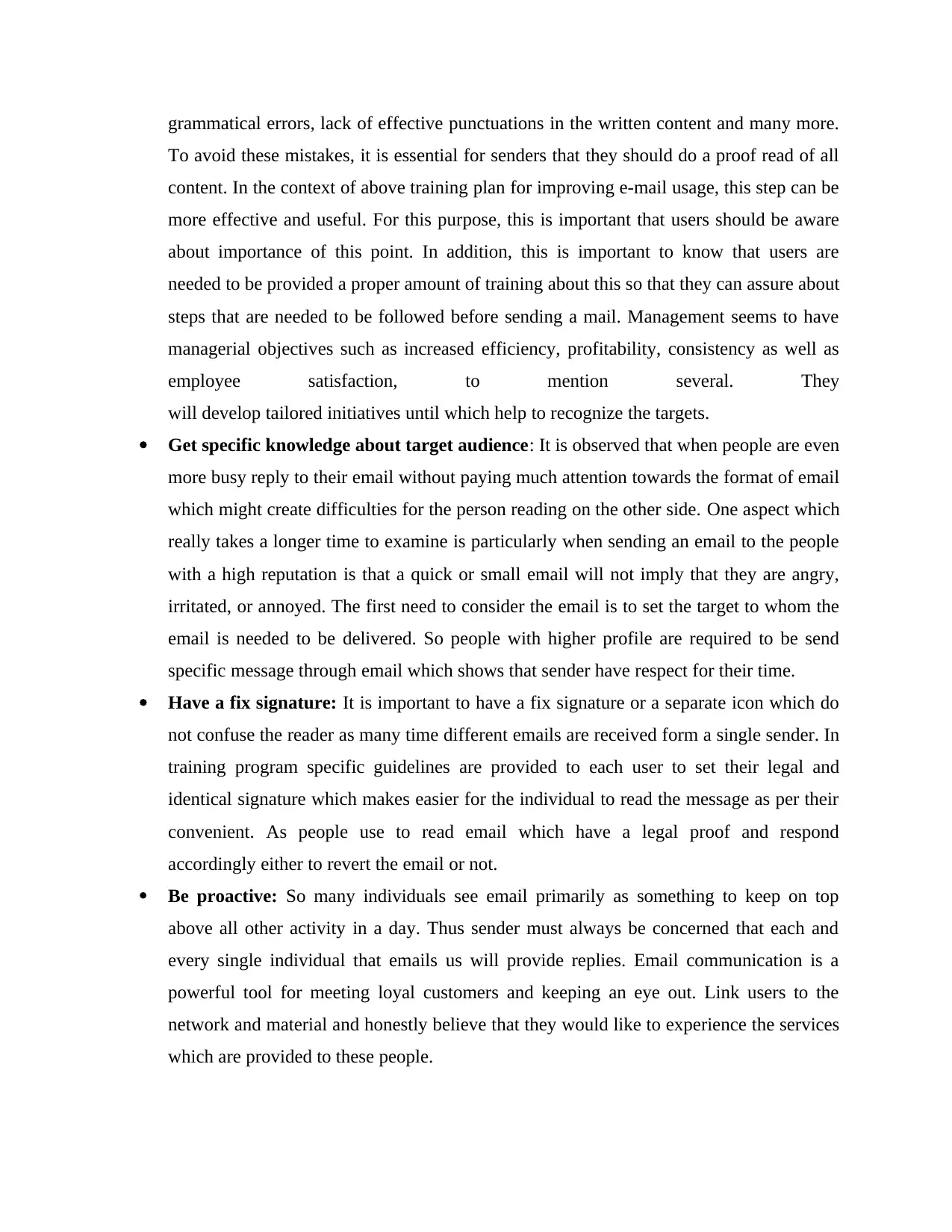
grammatical errors, lack of effective punctuations in the written content and many more.
To avoid these mistakes, it is essential for senders that they should do a proof read of all
content. In the context of above training plan for improving e-mail usage, this step can be
more effective and useful. For this purpose, this is important that users should be aware
about importance of this point. In addition, this is important to know that users are
needed to be provided a proper amount of training about this so that they can assure about
steps that are needed to be followed before sending a mail. Management seems to have
managerial objectives such as increased efficiency, profitability, consistency as well as
employee satisfaction, to mention several. They
will develop tailored initiatives until which help to recognize the targets.
Get specific knowledge about target audience: It is observed that when people are even
more busy reply to their email without paying much attention towards the format of email
which might create difficulties for the person reading on the other side. One aspect which
really takes a longer time to examine is particularly when sending an email to the people
with a high reputation is that a quick or small email will not imply that they are angry,
irritated, or annoyed. The first need to consider the email is to set the target to whom the
email is needed to be delivered. So people with higher profile are required to be send
specific message through email which shows that sender have respect for their time.
Have a fix signature: It is important to have a fix signature or a separate icon which do
not confuse the reader as many time different emails are received form a single sender. In
training program specific guidelines are provided to each user to set their legal and
identical signature which makes easier for the individual to read the message as per their
convenient. As people use to read email which have a legal proof and respond
accordingly either to revert the email or not.
Be proactive: So many individuals see email primarily as something to keep on top
above all other activity in a day. Thus sender must always be concerned that each and
every single individual that emails us will provide replies. Email communication is a
powerful tool for meeting loyal customers and keeping an eye out. Link users to the
network and material and honestly believe that they would like to experience the services
which are provided to these people.
To avoid these mistakes, it is essential for senders that they should do a proof read of all
content. In the context of above training plan for improving e-mail usage, this step can be
more effective and useful. For this purpose, this is important that users should be aware
about importance of this point. In addition, this is important to know that users are
needed to be provided a proper amount of training about this so that they can assure about
steps that are needed to be followed before sending a mail. Management seems to have
managerial objectives such as increased efficiency, profitability, consistency as well as
employee satisfaction, to mention several. They
will develop tailored initiatives until which help to recognize the targets.
Get specific knowledge about target audience: It is observed that when people are even
more busy reply to their email without paying much attention towards the format of email
which might create difficulties for the person reading on the other side. One aspect which
really takes a longer time to examine is particularly when sending an email to the people
with a high reputation is that a quick or small email will not imply that they are angry,
irritated, or annoyed. The first need to consider the email is to set the target to whom the
email is needed to be delivered. So people with higher profile are required to be send
specific message through email which shows that sender have respect for their time.
Have a fix signature: It is important to have a fix signature or a separate icon which do
not confuse the reader as many time different emails are received form a single sender. In
training program specific guidelines are provided to each user to set their legal and
identical signature which makes easier for the individual to read the message as per their
convenient. As people use to read email which have a legal proof and respond
accordingly either to revert the email or not.
Be proactive: So many individuals see email primarily as something to keep on top
above all other activity in a day. Thus sender must always be concerned that each and
every single individual that emails us will provide replies. Email communication is a
powerful tool for meeting loyal customers and keeping an eye out. Link users to the
network and material and honestly believe that they would like to experience the services
which are provided to these people.
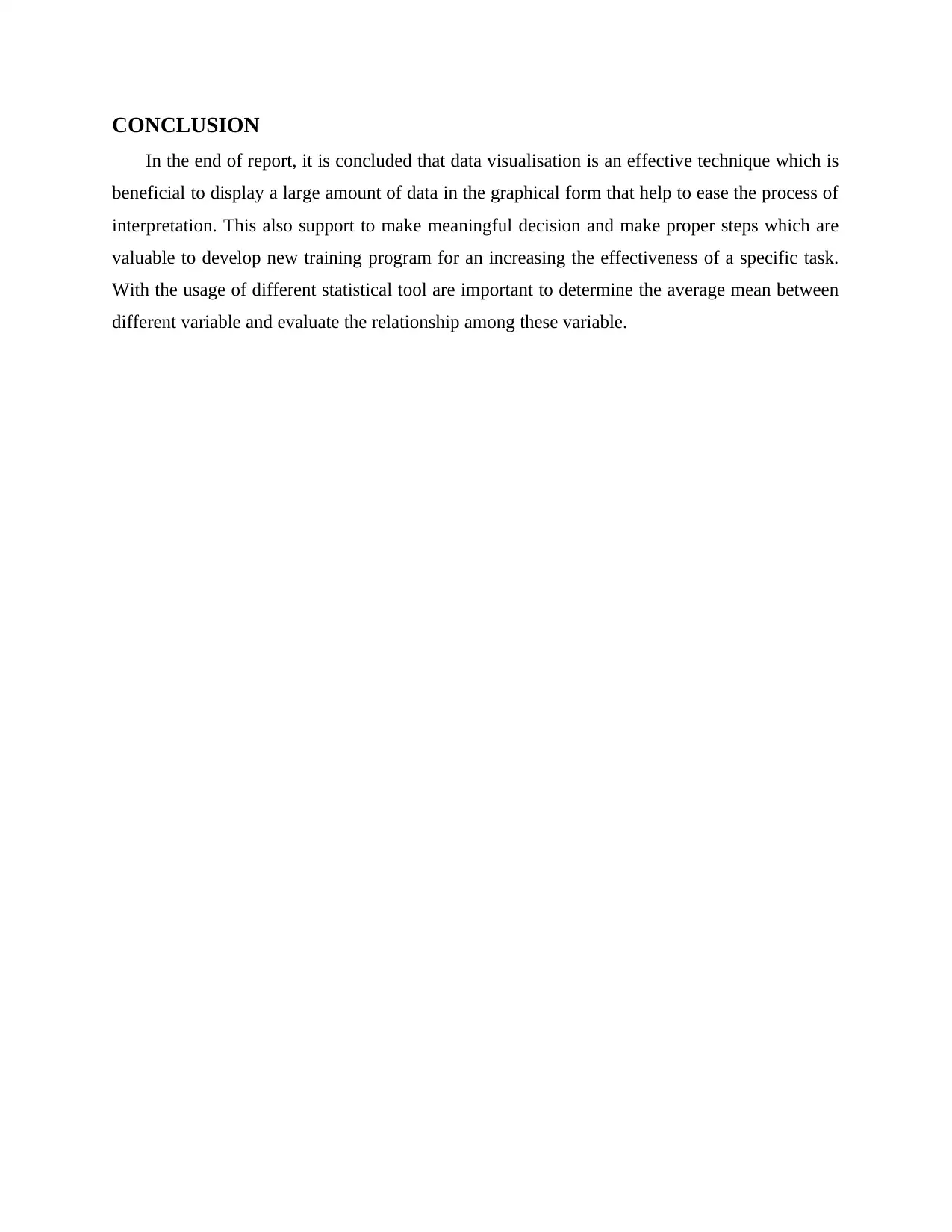
CONCLUSION
In the end of report, it is concluded that data visualisation is an effective technique which is
beneficial to display a large amount of data in the graphical form that help to ease the process of
interpretation. This also support to make meaningful decision and make proper steps which are
valuable to develop new training program for an increasing the effectiveness of a specific task.
With the usage of different statistical tool are important to determine the average mean between
different variable and evaluate the relationship among these variable.
In the end of report, it is concluded that data visualisation is an effective technique which is
beneficial to display a large amount of data in the graphical form that help to ease the process of
interpretation. This also support to make meaningful decision and make proper steps which are
valuable to develop new training program for an increasing the effectiveness of a specific task.
With the usage of different statistical tool are important to determine the average mean between
different variable and evaluate the relationship among these variable.
Secure Best Marks with AI Grader
Need help grading? Try our AI Grader for instant feedback on your assignments.
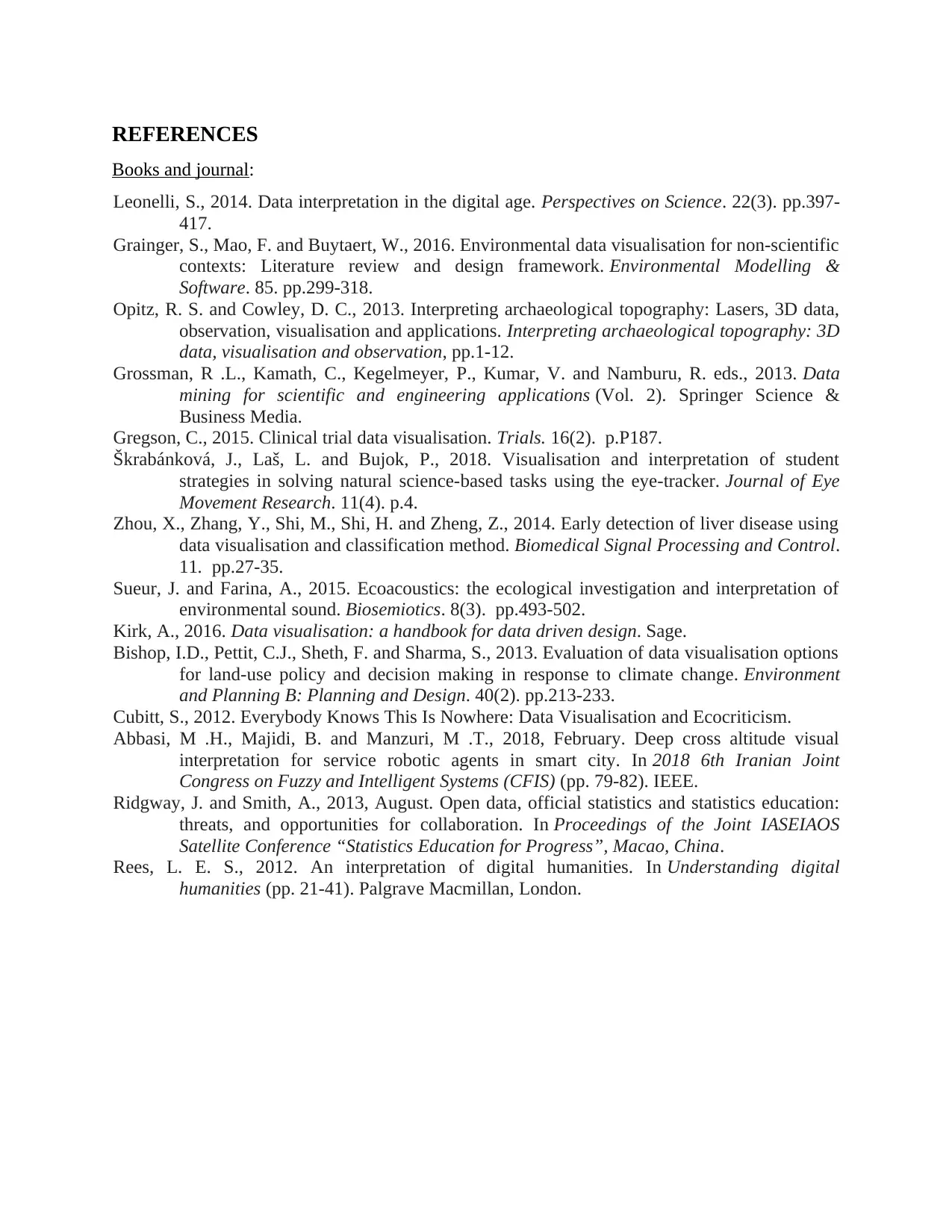
REFERENCES
Books and journal:
Leonelli, S., 2014. Data interpretation in the digital age. Perspectives on Science. 22(3). pp.397-
417.
Grainger, S., Mao, F. and Buytaert, W., 2016. Environmental data visualisation for non-scientific
contexts: Literature review and design framework. Environmental Modelling &
Software. 85. pp.299-318.
Opitz, R. S. and Cowley, D. C., 2013. Interpreting archaeological topography: Lasers, 3D data,
observation, visualisation and applications. Interpreting archaeological topography: 3D
data, visualisation and observation, pp.1-12.
Grossman, R .L., Kamath, C., Kegelmeyer, P., Kumar, V. and Namburu, R. eds., 2013. Data
mining for scientific and engineering applications (Vol. 2). Springer Science &
Business Media.
Gregson, C., 2015. Clinical trial data visualisation. Trials. 16(2). p.P187.
Škrabánková, J., Laš, L. and Bujok, P., 2018. Visualisation and interpretation of student
strategies in solving natural science-based tasks using the eye-tracker. Journal of Eye
Movement Research. 11(4). p.4.
Zhou, X., Zhang, Y., Shi, M., Shi, H. and Zheng, Z., 2014. Early detection of liver disease using
data visualisation and classification method. Biomedical Signal Processing and Control.
11. pp.27-35.
Sueur, J. and Farina, A., 2015. Ecoacoustics: the ecological investigation and interpretation of
environmental sound. Biosemiotics. 8(3). pp.493-502.
Kirk, A., 2016. Data visualisation: a handbook for data driven design. Sage.
Bishop, I.D., Pettit, C.J., Sheth, F. and Sharma, S., 2013. Evaluation of data visualisation options
for land-use policy and decision making in response to climate change. Environment
and Planning B: Planning and Design. 40(2). pp.213-233.
Cubitt, S., 2012. Everybody Knows This Is Nowhere: Data Visualisation and Ecocriticism.
Abbasi, M .H., Majidi, B. and Manzuri, M .T., 2018, February. Deep cross altitude visual
interpretation for service robotic agents in smart city. In 2018 6th Iranian Joint
Congress on Fuzzy and Intelligent Systems (CFIS) (pp. 79-82). IEEE.
Ridgway, J. and Smith, A., 2013, August. Open data, official statistics and statistics education:
threats, and opportunities for collaboration. In Proceedings of the Joint IASEIAOS
Satellite Conference “Statistics Education for Progress”, Macao, China.
Rees, L. E. S., 2012. An interpretation of digital humanities. In Understanding digital
humanities (pp. 21-41). Palgrave Macmillan, London.
Books and journal:
Leonelli, S., 2014. Data interpretation in the digital age. Perspectives on Science. 22(3). pp.397-
417.
Grainger, S., Mao, F. and Buytaert, W., 2016. Environmental data visualisation for non-scientific
contexts: Literature review and design framework. Environmental Modelling &
Software. 85. pp.299-318.
Opitz, R. S. and Cowley, D. C., 2013. Interpreting archaeological topography: Lasers, 3D data,
observation, visualisation and applications. Interpreting archaeological topography: 3D
data, visualisation and observation, pp.1-12.
Grossman, R .L., Kamath, C., Kegelmeyer, P., Kumar, V. and Namburu, R. eds., 2013. Data
mining for scientific and engineering applications (Vol. 2). Springer Science &
Business Media.
Gregson, C., 2015. Clinical trial data visualisation. Trials. 16(2). p.P187.
Škrabánková, J., Laš, L. and Bujok, P., 2018. Visualisation and interpretation of student
strategies in solving natural science-based tasks using the eye-tracker. Journal of Eye
Movement Research. 11(4). p.4.
Zhou, X., Zhang, Y., Shi, M., Shi, H. and Zheng, Z., 2014. Early detection of liver disease using
data visualisation and classification method. Biomedical Signal Processing and Control.
11. pp.27-35.
Sueur, J. and Farina, A., 2015. Ecoacoustics: the ecological investigation and interpretation of
environmental sound. Biosemiotics. 8(3). pp.493-502.
Kirk, A., 2016. Data visualisation: a handbook for data driven design. Sage.
Bishop, I.D., Pettit, C.J., Sheth, F. and Sharma, S., 2013. Evaluation of data visualisation options
for land-use policy and decision making in response to climate change. Environment
and Planning B: Planning and Design. 40(2). pp.213-233.
Cubitt, S., 2012. Everybody Knows This Is Nowhere: Data Visualisation and Ecocriticism.
Abbasi, M .H., Majidi, B. and Manzuri, M .T., 2018, February. Deep cross altitude visual
interpretation for service robotic agents in smart city. In 2018 6th Iranian Joint
Congress on Fuzzy and Intelligent Systems (CFIS) (pp. 79-82). IEEE.
Ridgway, J. and Smith, A., 2013, August. Open data, official statistics and statistics education:
threats, and opportunities for collaboration. In Proceedings of the Joint IASEIAOS
Satellite Conference “Statistics Education for Progress”, Macao, China.
Rees, L. E. S., 2012. An interpretation of digital humanities. In Understanding digital
humanities (pp. 21-41). Palgrave Macmillan, London.
1 out of 17
Your All-in-One AI-Powered Toolkit for Academic Success.
+13062052269
info@desklib.com
Available 24*7 on WhatsApp / Email
![[object Object]](/_next/static/media/star-bottom.7253800d.svg)
Unlock your academic potential
© 2024 | Zucol Services PVT LTD | All rights reserved.



